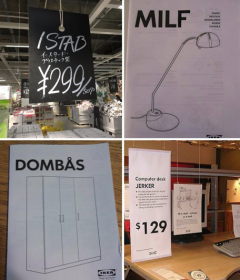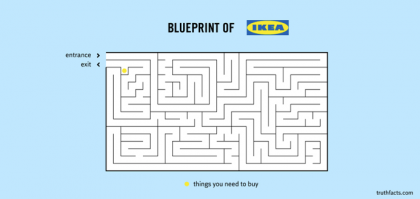How IKEA Flawlessly Brings The Customer Journey Mapping To Life

IKEA — the mystical land of flatpack furniture and Swedish meatballs.
There’s much to be said about this Swedish marvel of a business, starting from the fact that it remains the world’s largest furniture retailer and one of the most loved businesses worldwide.
So, what is it about the endless maze of open floor plans and decadent room displays that pulls us in? It can’t just be the pun-worthy names each item of furniture is endowed with or the neatly stacked rows of flatpack furniture just waiting to be unpacked and assembled. Akin to a Saturday morning sausage sizzle reward at Bunnings, there’s something about the experience of starting from the top and working your way through the maze of rooms, until you finally reach the haven of meatballs, soft-serve ice cream, and hot dogs.
What’s more: you get all of these things at a ridiculously low price. IKEA’s low costs for their furniture and food items is one of the key reasons why people suffer through the crowd to get there, time and time again. If that doesn’t appeal to customers, then their interesting choices of product names might.

NTWRK co-founder and chief customer and people officer Garreth Dorey said: “Short of it being a maze, it’s also a-mazing at bringing to life the customer experience and journey mapping in real-time engagement.”
Customer journey mapping comes to life
“Customer journeys are the roadmap of a business. IKEA takes it to the next level. There’s more to their floorplans than carefully laid out aesthetics and room segmentation. IKEA’s floorplan is, in fact, a very carefully curated labyrinth that brings the customer journey to life,” said Dorey.
Each phase of room displays, paired with conveniently-placed feature items, creates touchpoints for the brand to engage with its customers beyond just securing a sale. This interactive and intuitive journey is by no means a covert operation — customers walk into IKEA knowing full well they’re being led through a sales pitch. And yet, they still go in, and they still buy things they didn’t know they needed.

It’s funny because it’s true. Right?
IKEA’s level of genius isn’t just about trapping their customers within a seemingly inescapable maze with only one exit. Granted, some people might feel like mice trapped in a maze, but IKEA’s floor plan is in fact, genius. The customer’s literal journey through the store allows them to experience the buying process at their own leisure. It allows for every product available, with the burden of purchase being only a casual but terribly convenient suggestion.
Holding their hands, but from a distance
Despite appearances, customers aren’t just left to fend for themselves. Dorey said: “IKEA’s engagement and interactions with their customers come from a distance and with subtlety. Their touchpoints range from large arrows painted on the floor and overhead signages to customer service and interactive IKEA information hubs.”
Subtlety is one of IKEA’s strong suits when it comes to crafting its physical and theoretical customer journey. Judging by the success of this global business and brand, balancing subtlety with obvious marketing goes a long way.
Maze with a meaning
“It’s all about perspective with IKEA. Customers walk in and experience immaculate interior design that could be their own. Beds to lie on, couches to rest their weary feet, neatly organised kitchens to strive towards. People walk into IKEA to experience the living space they dream of — and IKEA provides them with an opportunity to achieve these dreams. Each layout emphasises the idea of perspective and interactivity between customers and business,” said Dorey.
The ability to experience the products firsthand further boosts chances of purchases being made, or rather, increases the likelihood of conversion. Because the layout of the showrooms is a little tedious to manoeuvre more than once, customers are encouraged to make quick conversion decisions in regards to their purchases.
We’ve all done those drive-by purchases — packs of multi-coloured food clips, food containers, assorted kitchenware. Things that weren’t on our buying list but somehow made it into our reusable blue bags anyway. IKEA is a haven for impulse purchases, but that isn’t necessarily a bad thing.
IKEA gets away with these blatant marketing tactics for one simple reason — they add value. Customers venturing into their maze of display rooms and warehouses more often than not come away with a purchase they’re satisfied with. No matter the size of their purchases, they’re getting value out of their conversion one way or another.
The IKEA customer journey map isn’t all that hard to implement. It takes is some subtle customer engagement and a curated customer experience that’ll leave them coming back for more. After all, cheap, high-quality product is worth the adventure.
And if nothing else, there’s always Swedish meatballs!
Latest News

TV Ratings (18/04/2024): I’m A Celebrity Wins Prime Time And Key Demos
Aussie viewers can be a harsh lot at times. Only days after Ellie Cole bled her heart out, she has been sent packing.

Effie&co Launches New ConnectAsia Division To Help Aussie Brands Market To Asian Consumers Overseas & At Home
Not provided is advice on using chopsticks and not spilling ramen down your shirt.

Cashrewards Sets Out Stall For New CMO
Thinking of applying for the Cashrewards CMO gig? Here are some insider tips that, yes, are tantamount to cheating.

‘I Ask For The TV Industry To Stand Up And Defend Itself’ – Seven Boss James Warburton Steps Down
The Seven supremo heads for the exits after five years. Here's hoping the Spotlight team organised the farewell bash.

Poh! Jamie! Adriano! Paramount ANZ reveals its tasty plans for this year’s MasterChef
It's your fan's guide to this year's MasterChef! Although no tips on how to pronounce crudités or use a un fait-tout.

Dentsu’s iProspect Partners With MOOD Tea Ahead Of May Campaign Launch
We love a Mood Tea here at B&T. Although we do store old screws and nails in the International Roast caterer's tin.

Opinion: When Culture Starts Eating Itself: Navigating The Age Of Self-eating Nostalgia
Born boss David Coupland asks is adland going through a nostalgia period? But please, no repeats of Best Of Red Faces.

Who’s Going To Cannes?! The TikTok Young Lions Winners!
It's Aussie adland's next gen! They're off to Cannes with high hopes of bringing back a Lion & a foot-long Toblerone.

Adobe Launches Express Mobile App With Firefly AI
Want to be the coolest kid at Friday staff drinks but forgot your retro Nikes? This new Adobe wizardry may do the trick.

ThinkNewsBrands & IMAA Extend News Publishing Education In Brisbane
Industry duo takes its publishing roadshow to Brisbane. Was disappointed no male attendees were wearing walk socks.

B&T Chats With Wavemaker’s Provocative Pioneers On Their Cross-Pacific Sojourn
B&T TV heads to Wavemaker's Sydney digs to interview two staffers from its New York & LA digs. If that makes sense?

HoMie & Champion Launch “Give One. Get One” Campaign Supporting Youth Homelessness Via Town Square
Much like the fête's prized chutney wears a blue winners sash, so too should this top initiative from HoMie & Champion.

Thinkerbell Takes Us Back To Summer In Latest Work For XXXX
This beer ad wants to take you back to summer! Just minus any chance of a shark attack on your morning bus commute.

Cannes Lions Unveils 2024 Programme Featuring Queen Latifah, Jay Shetty & P&G’s Mark Pritchard
Are you one of the lucky ducks heading to Cannes in June? Check out the headliner acts you'll be queueing hours to see.

Scroll Media Recruits Costa Panagos From Twitch
Costa Panagos set to bring South American flair to the Scroll offices. Assuming that he is, indeed, South American.

Year13, Microsoft & KPMG Australia Launch AI Course For Gen Zs
Born around the 2000s? Need to amp up your AI creds? This guide's for you (although it's not really that age specific).

General Motors Snares Heath Walker From Scania
Do you rage about oversized American cars on our roads? You need to bail up Heath Walker at parties & industry events.

VML Launches New “Envoyage” Brand For Flight Centre
VML unveils new brand for travel operator Flight Centre. Alas, no sign of those paid actors pretending to be pilots.

Subaru Places Media Account Up For Review
Subaru puts media up for review, as adland journos get set for mandatory "agency drives off with..." headline.

TV Ratings (17/04/2024): Contestants Faced With Harsh Realities As Alone Australia Heats Up (Or Cools Down)
Alone still doing the business for SBS. Overly long train journeys not doing the business, but they persist anyway.

Ben Fordham Loses Number One Spot As Ray Hadley Celebrates 156th Ratings Win
The radio numbers are in! Discover who's off for a boozy lunch today & who's waiting for the dreaded HR death knock.

Gourmet Ice Cream Brand Connoisseur Launches New “Thrill Your Senses” Iteration, Via SICKDOGWOLFMAN
Rattling the old "truth in advertising" adage comes this ice-cream spot full of noticeably thin people.

Paramount’s Global Sales Boss: ‘Australia’s Converged Model Is A Blueprint For How I’d Like All Of Our Markets To Be’
Paramount's global sales boss gives local sales ops the thumbs up. Didn't weigh-in on the Lisa Wilkinson debacle.

TikTok Starts Testing Its Instagram Rival In Australia
In exciting news for piano playing cats & brattish pranks in shopping centres, TikTok unveils its Insta rival plans.

Man Wrongly Named By Seven As Bondi Killer Hires Lawyers
Struggling to save for a house deposit? Why not get wrongly identified by Sunrise!

Smartsheet Appoints Indie Agency Sandbox Media To Its Media Account
Can't stand your colleagues? Like to dob them in when they miss a deadline? These work management platforms are ideal.

Boss Not Letting You Come To Cannes In Cairns? Use This Business Case To Convince Them!
Stingy boss won't spring for a ticket to Cairns? Add this to your persuasive argument repertoire. Or grovel.

Alt/shift/ Brisbane Builds Portfolio With Ausbuild Creative, PR, Content & Social Account Win
The Brisbane comms/PR agency lands constructor Ausbuild. Also hoping for a discount on its new glass conservatory.

Young Guns Versus The Old Guard: Who Adds More Value to Our Industry?
Cannes In Cairns poking this hornet's nest in a lively debate. Just so long as the oldies can get up the stairs.

70% Of Aussies Don’t Have Green Power Plans ENGIE Says In Major Brand Campaign Via HERO
Are you the notorious "light leaver on-er" in your flatshare? Quell any infighting with this green energy news.

PrettyGood Launches Offering Brand & Media Solutions For Australasian SMEs
B&T applauds the charitable nature of this new agency. Although we'd hate to see it impact any Chrissie present sends.

A Blunt End: Dolphins Medicinal Cannabis Sponsorship At Risk
Yes, it's another NRL drug story. Yet, thankfully it doesn't involve coke in Kuta during the off-season.

Slew Of New Creative Hires At Leo Burnett Australia
Ahhh, all black! The outfit of choice for agency creatives, David Jones staff and everyone in Melbourne.

Under Armour Unveils Local “Live in UA” Campaign
American apparel brand set for yet another tilt at the Aussie market, as Nike declares "we'll see about that".

Pepsi Launches New Look, Refreshing Classic Fashion Staples Via Special PR
Are you always the bridesmaid, never the bride, as the old saying goes? How do you think Pepsi feels?

Pure Blonde Returns To A Place Purer Than Yours In New Campaign Via The Monkeys
B&T's always been a huge fan of the 'drink yourself thinner' diet plan. So big thanks to Pure blonde, vodka & tequila.
